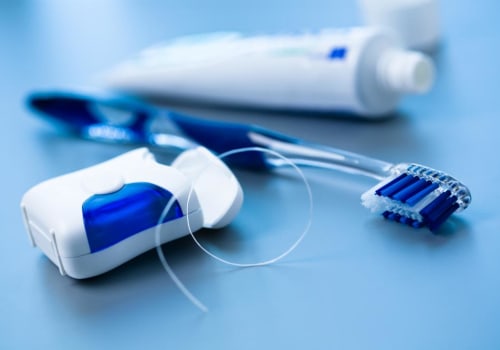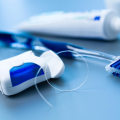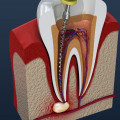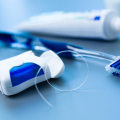Preventing Tooth Decay: Fluoride and Sealants
Are you looking for ways to protect your teeth from decay?
In this article, we will delve into the effectiveness of fluoride and dental sealants in preventing tooth decay. You'll learn about the role of fluoride in dental preventive care and how dental sealants can provide a protective barrier.
We'll also walk you through the process of getting sealants and offer tips on maintaining oral hygiene with fluoride and sealants. This will also emphasize the importance of seeking professional guidance from professionals like Dr. Matthew S. Wittrig, DDS, a dentist in Greenwood Indiana, to ensure the effectiveness of these preventive measures for your long-term oral health.
Say goodbye to cavities and hello to a healthier smile!
Key Takeaways
- Brush teeth thoroughly for at least two minutes, reaching all surfaces including back teeth and gumline.
- Use fluoride toothpaste consistently to strengthen tooth enamel and prevent decay.
- Limit intake of sugary foods and drinks to reduce acid production and enamel erosion.
- Consider getting dental sealants to protect molars and reduce the risk of cavities.
Introduction
When it comes to maintaining good oral health, preventing tooth decay should be a top priority for you. Tooth decay can lead to cavities, tooth pain, and even tooth loss if left untreated. Luckily, there are preventive measures such as fluoride and sealants that can greatly help in keeping your teeth strong and healthy.
Fluoride is a mineral that strengthens tooth enamel and helps to prevent tooth decay, while sealants are protective coatings that can be applied to the chewing surfaces of the back teeth to prevent bacteria from causing decay.
The Importance of Preventing Tooth Decay
To prevent tooth decay, you should make sure to prioritize the importance of maintaining good oral hygiene habits. This means brushing your teeth twice a day, using fluoride toothpaste, and flossing daily. Additionally, regular dental check-ups and cleanings are crucial to detect and prevent any early signs of tooth decay.
Here are three important habits to help prevent tooth decay:
- Brush your teeth thoroughly: Spend at least two minutes brushing your teeth, making sure to reach all surfaces, including the back teeth and gumline.
- Use fluoride toothpaste: Fluoride helps strengthen tooth enamel and prevent decay. Look for toothpaste that contains fluoride and use it consistently.
- Limit sugary foods and drinks: Sugar feeds the bacteria in your mouth, leading to acid production that can erode tooth enamel. Try to reduce your intake of sugary snacks, sodas, and juices.
How Fluoride and Sealants Can Help
You can significantly reduce your risk of cavities by getting dental sealants applied to your molars. Dental sealants are a protective coating that is applied to the chewing surfaces of your back teeth.
These sealants act as a barrier, preventing bacteria and food particles from getting trapped in the natural grooves and pits of your molars. By creating a smooth surface, sealants make it easier to clean your teeth and keep them cavity-free.
The application process is quick and painless, with the dentist simply painting the sealant onto your teeth and allowing it to harden. Sealants can last for several years and are a cost-effective way to maintain good oral health.
Talk to your dentist about getting sealants to protect your molars and reduce your risk of cavities.
Understanding Tooth Decay
So, you want to understand tooth decay and its consequences?
Well, first of all, tooth decay is the destruction of the tooth's outer layer, called enamel, due to the acids produced by plaque bacteria.
This decay process can lead to a range of consequences if left untreated.
These consequences include toothache, sensitivity to hot and cold temperatures, bad breath, and even tooth loss in severe cases.
What Is Tooth Decay
Tooth decay, also known as dental caries, occurs when the enamel of your teeth is damaged and starts to break down. This decay is caused by a combination of factors, including the presence of bacteria in your mouth, poor oral hygiene habits, and a diet high in sugar and carbohydrates.
If left untreated, tooth decay can lead to pain, infection, and even tooth loss.
Definition and Causes
Start by understanding the definition of tooth decay and its common causes.
Tooth decay, also known as dental caries, is the destruction of the tooth's structure due to acids produced by bacteria in the mouth. The main causes of tooth decay include poor oral hygiene, a diet high in sugar and carbohydrates, and a lack of fluoride.
Remember to brush and floss regularly, limit sugary foods and drinks, and use fluoride toothpaste to prevent tooth decay.
The Consequences of Untreated Tooth Decay
Now let's dive into the topic of cavities and tooth pain.
If you've ever experienced a toothache, you know just how uncomfortable and debilitating it can be. Cavities, also known as dental caries, are one of the main causes of tooth pain. They occur when the bacteria in your mouth produce acids that eat away at the tooth enamel, resulting in decay and potential pain.
In this discussion, we'll explore the causes, symptoms, and treatment options for cavities, as well as ways to prevent them and alleviate tooth pain.
Discussing Cavities and Tooth Pain
If you're experiencing tooth pain, it's important to address cavities promptly. Cavities are caused by decay in your teeth, which can lead to sensitivity, pain, and even infection.
Here are a few things to consider when dealing with cavities:
- Schedule a dental appointment to get a proper diagnosis and treatment plan.
- Practice good oral hygiene by brushing and flossing regularly.
- Limit your intake of sugary foods and drinks to prevent further decay.
Fluoride in Dental Preventive Care
Fluoride is a mineral that plays a crucial role in preventing tooth decay. It strengthens the enamel, making it more resistant to acid attacks from plaque bacteria and sugars in the mouth.
The benefits of fluoride in preventing tooth decay are numerous, including reducing the risk of cavities and promoting overall oral health.
You can find fluoride in various sources, such as fluoridated water, toothpaste, mouth rinses, and professional dental treatments.
What Is Fluoride
Fluoride plays a crucial role in preventing tooth decay and maintaining good oral health. It works by strengthening the enamel, the outer layer of your teeth, making it more resistant to acid attacks from plaque bacteria and sugary foods.
This mineral also helps to remineralize the teeth, repairing any early signs of tooth decay.
Explanation of Fluoride's Role
When it comes to preventing tooth decay, you'll be glad to know that fluoride plays a crucial role. It helps to strengthen your tooth enamel, making it more resistant to acid attacks from bacteria and plaque.
By incorporating fluoride into your dental care routine, you can protect your teeth and reduce your risk of cavities. Here are three ways fluoride benefits your oral health:
- Strengthens tooth enamel
- Protects against acid attacks
- Reduces the risk of cavities
Benefits of Fluoride in Preventing Tooth Decay
When it comes to preventing tooth decay, fluoride plays a crucial role. It strengthens tooth enamel and inhibits bacterial growth. By strengthening tooth enamel, fluoride helps make your teeth more resistant to acid attacks from plaque bacteria and sugary foods. Additionally, fluoride inhibits the growth of harmful bacteria in the mouth, reducing the risk of cavities and gum disease.
Strengthening Tooth Enamel
Brushing and flossing regularly can help strengthen tooth enamel, reducing the risk of tooth decay. To further protect your enamel, consider these tips:
- Limit acidic foods and drinks: Acidic substances can erode enamel over time, so try to minimize consumption of things like citrus fruits, soda, and vinegar-based products.
- Use fluoride toothpaste and mouthwash: Fluoride helps remineralize enamel and make it more resistant to decay.
- Avoid brushing too hard: Brushing vigorously can actually wear down enamel, so use a soft-bristled toothbrush and gentle technique.
Inhibiting Bacterial Growth
One effective way to inhibit bacterial growth in the mouth is by limiting the consumption of sugary and starchy foods. These types of foods provide an ideal environment for bacteria to thrive and multiply, leading to tooth decay and cavities. By reducing your intake of sugary snacks, sodas, and carbohydrates, you can help create a less favorable environment for harmful bacteria. Incorporating a balanced diet rich in fruits, vegetables, and lean proteins will promote good oral health.
| Foods to Limit | Alternative Options |
| Soda | Water |
| Candy | Fresh fruit |
| Chips | Raw vegetables |
Sources of Fluoride
When it comes to maintaining good oral health, there are several sources of fluoride that you should be aware of.
Firstly, drinking water that contains fluoride is an important way to strengthen your teeth and prevent tooth decay.
Additionally, using fluoride toothpaste when brushing your teeth can provide an extra layer of protection.
Finally, professional fluoride treatments at your dentist's office can be a highly effective way to further strengthen your teeth and prevent cavities.
Drinking Water
If you drink tap water that contains fluoride, it can help prevent tooth decay. Fluoridated water is a cost-effective way to protect your teeth and improve oral health.
Here are three reasons why drinking fluoridated water is beneficial:
- Strengthens tooth enamel: Fluoride helps to strengthen the enamel, making it more resistant to acid attacks from plaque and bacteria.
- Remineralizes teeth: Fluoride promotes the remineralization of weakened tooth enamel, reversing early stages of tooth decay.
- Reduces cavities: Studies have shown that communities with fluoridated water have significantly lower rates of tooth decay compared to those without fluoride.
Fluoride Toothpaste
Using fluoride toothpaste is an effective way to strengthen tooth enamel and prevent cavities. When you brush your teeth with fluoride toothpaste, the fluoride ions penetrate the tooth enamel, making it more resistant to acid attacks from bacteria and sugars. This helps to prevent tooth decay and cavities. Look for toothpaste with fluoride content of at least 1,000 parts per million (ppm) to ensure maximum protection. Remember to brush your teeth twice a day for two minutes each time, using a pea-sized amount of fluoride toothpaste.
| Benefits of Using Fluoride Toothpaste |
| Strengthens tooth enamel |
| Prevents cavities |
| Protects against acid attacks |
Fluoride toothpaste not only strengthens your teeth but also helps to prevent cavities. By using a fluoride toothpaste, you are providing an extra layer of protection for your teeth, making them more resistant to decay. Make sure to choose a toothpaste with a fluoride content of at least 1,000 ppm to ensure optimum effectiveness. Remember to brush your teeth thoroughly for two minutes, twice a day, to maintain good oral hygiene.
Professional Fluoride Treatments
To maximize the benefits of professional fluoride treatments, it's important to schedule regular appointments with your dentist. These treatments are highly effective in preventing tooth decay and strengthening your teeth.
Here are three reasons why professional fluoride treatments are beneficial:
- Professional application: Dentists have the expertise to properly apply fluoride treatments, ensuring maximum effectiveness.
- Higher concentration: Professional fluoride treatments contain a higher concentration of fluoride than over-the-counter products, providing better protection for your teeth.
- Customized approach: Your dentist will assess your specific dental needs and tailor the fluoride treatment accordingly, ensuring optimal results.
Dental Sealants: A Protective Barrier
Dental sealants are a protective barrier that is applied to the chewing surfaces of your teeth to help prevent tooth decay. They are made of a thin plastic material that is painted onto the teeth, where it bonds and hardens, creating a shield against bacteria and acids.
Sealants work by sealing off the grooves and pits on the teeth, making it harder for plaque and food particles to get trapped and cause cavities. They are especially beneficial for children, as their developing teeth are more susceptible to decay and may not be as efficient at cleaning hard-to-reach areas.
What Are Dental Sealants
Dental sealants are a protective coating that is typically applied to the chewing surfaces of your back teeth. Their purpose is to create a barrier against bacteria and food particles, helping to prevent tooth decay.
These sealants are made of a plastic material that is painted onto the teeth, filling in the deep grooves and pits where bacteria can accumulate.
Definition and Purpose
Fluoride and sealants are used to prevent tooth decay. Dental sealants are thin coatings that are applied to the chewing surfaces of the back teeth. They act as a barrier, protecting the teeth from bacteria and acids that cause cavities. The sealants are made of a plastic material that bonds to the tooth and hardens. They are a safe and effective way to prevent tooth decay, especially in children and teenagers.
Dental sealants are clear or white in color, making them virtually invisible. The application of sealants is painless and quick, usually taking just a few minutes per tooth. Sealants can last for several years with proper oral hygiene practices and regular dental check-ups.
How Dental Sealants Work
When it comes to the sealant application process, there are a few key points to keep in mind.
First, the tooth surface must be thoroughly cleaned and dried before the sealant can be applied.
Once the tooth is prepped, the dental professional will then carefully paint the sealant onto the grooves and pits of the tooth, ensuring complete coverage.
Sealant Application Process
To properly apply sealants, you'll need to have your teeth thoroughly cleaned and dried by the dental hygienist. Once your teeth are ready, the sealant application process begins. Here's what you can expect during this procedure:
- First, the dental hygienist will isolate the teeth to be sealed by placing a rubber dam or cotton rolls around them.
- Next, the teeth will be etched with a special gel to create a rough surface that allows the sealant to bond effectively.
- Finally, the sealant is applied to the grooves and pits of the teeth and hardened with a curing light. This creates a protective barrier that helps prevent decay.
Sealants for Children
When it comes to sealants for children, understanding the importance and timing is crucial.
Sealants are a preventive measure that can significantly reduce the risk of tooth decay in children.
It is recommended to have sealants applied as soon as the permanent molars erupt, usually around the age of 6, and again when the second set of permanent molars come in around the age of 12.
Importance and Timing
Make sure you understand the importance and timing of fluoride and sealants for preventing tooth decay.
Fluoride is a mineral that strengthens tooth enamel and helps prevent cavities. It is typically found in toothpaste, mouth rinses, and public water supplies.
Sealants, on the other hand, are thin plastic coatings applied to the chewing surfaces of molars to protect them from plaque and bacteria.
Both fluoride and sealants are essential for maintaining good oral health and preventing tooth decay.
The Process of Getting Sealants
When it comes to getting sealants, there are several important steps involved.
First, you will undergo a dental examination to ensure that sealants are the right option for you.
Then, your dentist will thoroughly clean and prepare your teeth by removing any plaque or debris.
Next, the sealant application process begins, where a thin layer of protective coating is applied to your teeth.
Dental Examination
When it comes to identifying eligible teeth for dental examinations, there are a few key points to keep in mind.
Firstly, it's important to consider the age of the individual, as dental needs may vary depending on whether they are a child or an adult.
Secondly, the condition of the teeth, such as the presence of cavities or other dental issues, should also be taken into account.
Lastly, the position and alignment of the teeth can affect eligibility, as certain dental examinations may be more suitable for individuals with specific tooth arrangements.
Identifying Eligible Teeth
To identify eligible teeth for fluoride treatment or sealants, you should consult with your dentist. They will assess your dental health and determine which teeth can benefit from these preventive measures.
Here are some factors that your dentist will consider:
- Presence of tooth decay: Teeth with existing decay may require additional treatment before fluoride or sealant application.
- Tooth structure: Teeth with deep grooves and fissures are more prone to decay and may benefit from sealants.
- Oral hygiene habits: Patients with poor oral hygiene may need fluoride treatment to strengthen their teeth.
Consulting with your dentist will ensure that the appropriate teeth receive the necessary preventive care.
Cleaning and Preparing the Teeth
When it comes to ensuring proper adhesion of dental materials, there are a few key points to keep in mind.
First, it is crucial to thoroughly clean and prepare the teeth before applying any adhesive. This involves removing any plaque or debris, as well as roughening the surface of the tooth to promote better bonding.
Additionally, using a bonding agent or primer can help enhance the adhesion of the dental material to the tooth structure.
Ensuring Proper Adhesion
Make sure you're applying enough pressure when brushing to ensure proper adhesion of the fluoride and sealants. This is important because it allows the fluoride and sealants to bond effectively to the teeth, providing maximum protection against tooth decay.
To ensure proper adhesion, remember to:
- Use a soft-bristled toothbrush to avoid damaging the enamel.
- Brush in small circular motions, covering all surfaces of the teeth.
- Spend at least two minutes brushing to thoroughly apply the fluoride and sealants.
Sealant Application
So you've decided to learn about sealant application, a crucial step in preventing tooth decay. Let's walk through the step-by-step procedure so you can fully understand how it's done.
First, the teeth are thoroughly cleaned and dried to ensure optimal adhesion.
Then, an etching solution is applied to create a rough surface for the sealant to bond to.
Step-by-Step Procedure
To prevent tooth decay, start by brushing your teeth twice a day and flossing daily. This will help remove plaque and food particles that can lead to decay.
Additionally, consider incorporating fluoride toothpaste into your oral care routine. Fluoride strengthens tooth enamel and helps protect against cavities.
Another preventive measure is getting dental sealants. These thin, protective coatings are applied to the chewing surfaces of your back teeth to seal out bacteria and prevent decay.
Checking and Polishing
To ensure a smooth surface for your teeth, there are a few key points to keep in mind.
First, your dentist will carefully check the sealants to make sure they are properly applied and bonded to your teeth.
They will also check for any rough edges or uneven surfaces that could potentially trap food particles.
Ensuring a Smooth Surface
Regular brushing and flossing help ensure a smooth surface for your teeth, reducing the risk of tooth decay.
To further protect your teeth, consider these additional steps:
- Use a fluoride toothpaste to strengthen your enamel and prevent cavities.
- Consider getting dental sealants, a protective coating applied to the chewing surfaces of your back teeth.
- Visit your dentist regularly for professional cleanings and check-ups to maintain a smooth and healthy smile.
Maintaining Oral Hygiene with Fluoride and Sealants
To maintain optimal oral hygiene, it is important to establish a daily dental care routine. This routine should include brushing your teeth twice a day with fluoride toothpaste, flossing daily to remove plaque and food particles, and using mouthwash to freshen your breath and kill bacteria.
In addition to your daily routine, regular dental checkups are crucial for preventing and detecting oral health issues early on. Visiting your dentist every six months allows for professional cleanings, thorough examinations, and the opportunity to discuss any concerns or questions you may have.
Lastly, your dietary habits play a significant role in your oral health. Limiting the consumption of sugary foods and drinks, as well as avoiding tobacco products, can greatly reduce the risk of tooth decay, gum disease, and other oral health problems.
Daily Dental Care Routine
When it comes to maintaining good oral hygiene, brushing and flossing are key. To ensure you're doing it correctly, here are some helpful tips.
First, make sure you're using a soft-bristled toothbrush and fluoride toothpaste to effectively remove plaque and bacteria.
Next, brush your teeth at least twice a day for two minutes each time, focusing on all surfaces of your teeth, including the gumline.
Brushing and Flossing Tips
Make sure you're using a soft-bristled toothbrush and brushing in small circular motions to effectively clean your teeth and gums. Remember, brushing alone is not enough.
Here are three important tips to enhance your oral hygiene routine:
- Brush for at least two minutes, twice a day
- Don't forget to clean your tongue to remove bacteria
- Use dental floss daily to remove plaque and food particles from between your teeth.
Regular Dental Checkups
When it comes to maintaining the integrity of your dental sealants, regular monitoring is crucial. By regularly checking the condition of your sealants, you can ensure that they are providing effective protection against tooth decay.
During your dental checkups, your dentist will carefully examine the sealants for any signs of wear, chipping, or deterioration, and take necessary steps to repair or replace them as needed.
Monitoring Sealant Integrity
Check if your sealants are intact by regularly examining them in the mirror. It is important to monitor the integrity of your sealants to ensure they are effectively protecting your teeth from decay.
Here are three things to look for when checking your sealants:
- Any visible cracks or chips in the sealant material
- Gaps or spaces between the tooth and the sealant
- Discoloration or staining on the sealant surface
If you notice any of these issues, it's important to schedule a dental appointment to have your sealants repaired or replaced.
Dietary Habits
When it comes to maintaining good oral health, it's important to pay attention to your dietary habits. There are certain foods and drinks that you should avoid in order to prevent tooth decay and other dental issues.
High-sugar foods and beverages like candy, soda, and fruit juices can contribute to the formation of plaque and cavities. Additionally, acidic foods and drinks such as citrus fruits and carbonated drinks can erode the enamel of your teeth, leading to sensitivity and potential damage.
Foods and Drinks to Avoid
Avoid consuming sugary foods and drinks, as they can contribute to tooth decay. Sugary foods and drinks are a major culprit when it comes to tooth decay. They provide a breeding ground for harmful bacteria in your mouth, which produce acids that erode your tooth enamel.
Avoiding sugary foods and drinks is crucial for maintaining good oral health. Instead, opt for healthier alternatives such as water, unsweetened tea, and snacks like fruits and vegetables.
Conclusion
Remember, fluoride and sealants are both effective ways to prevent tooth decay and maintain good oral health.
Fluoride is a mineral that strengthens your teeth and helps to prevent cavities. It can be found in toothpaste, mouthwash, and even in your drinking water. Using fluoride toothpaste and rinsing with a fluoride mouthwash can help to protect your teeth from decay.
Sealants, on the other hand, are thin plastic coatings that are applied to the chewing surfaces of your back teeth. They create a barrier that prevents bacteria and food particles from getting stuck in the crevices of your teeth, reducing the risk of cavities. Sealants are especially beneficial for children and teenagers who may have difficulty cleaning their teeth properly.
It is important to remember that while fluoride and sealants are effective in preventing tooth decay, they should be used in conjunction with a proper oral hygiene routine. This includes brushing your teeth twice a day, flossing regularly, and visiting your dentist for regular check-ups and cleanings.
Frequently Asked Questions
Are There Any Side Effects or Risks Associated With Using Fluoride in Dental Preventive Care?
Are there any side effects or risks with using fluoride in dental preventive care?
It's important to consider this question when it comes to your oral health. Fluoride is commonly used in preventive dentistry as it helps to strengthen teeth and protect against tooth decay. However, like any medication or treatment, there may be potential side effects.
It's always best to consult with your dentist to determine the appropriate use of fluoride and address any concerns you may have.
How Long Do Dental Sealants Typically Last Before They Need to Be Replaced?
Dental sealants are a great way to prevent tooth decay. They are a thin, protective coating that is applied to the chewing surfaces of your back teeth.
The sealants act as a barrier, preventing bacteria and food particles from getting stuck in the grooves and causing cavities.
Typically, dental sealants can last up to 10 years before they need to be replaced. However, it's important to visit your dentist regularly for check-ups to ensure the sealants are still intact and functioning effectively.
Can Adults Benefit From Getting Dental Sealants, or Are They Only Recommended for Children?
Adults can definitely benefit from getting dental sealants, not just children. Dental sealants are a protective coating that is applied to the chewing surfaces of teeth to prevent tooth decay. They act as a barrier against plaque and bacteria, reducing the risk of cavities.
While sealants are commonly applied to children's teeth, adults with deep grooves or pits in their teeth can also benefit from sealants. It's a simple and painless procedure that can provide long-lasting protection for your teeth.
Is It Possible to Have Too Much Fluoride in Your System, and if So, What Are the Potential Consequences?
Yes, it is possible to have too much fluoride in your system, and there can be potential consequences. When you consume excessive amounts of fluoride, a condition called fluorosis may occur. This can lead to discoloration and mottling of the teeth, ranging from white spots to brown stains. In severe cases, the enamel can become pitted and rough.
It's important to follow the recommended fluoride guidelines to prevent these effects and maintain optimal oral health.
Are There Any Alternative Treatments or Methods for Preventing Tooth Decay That Do Not Involve Fluoride or Dental Sealants?
There are alternative treatments and methods for preventing tooth decay that do not involve fluoride or dental sealants. Some options include practicing good oral hygiene, such as brushing your teeth twice a day and flossing regularly.
Additionally, maintaining a healthy diet that is low in sugary foods and drinks can help prevent tooth decay. Regular dental check-ups and cleanings are also important for detecting and addressing any potential issues early on.
It's important to consult with your dentist to determine the best approach for your specific needs.






